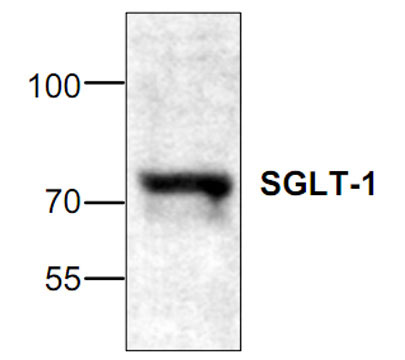SGLT-1 Antibody
Rabbit Polyclonal Antibody
- SPECIFICATION
- CITATIONS
- PROTOCOLS
- BACKGROUND

Application
| WB |
|---|---|
| Primary Accession | P13866 |
| Reactivity | Human |
| Host | Rabbit |
| Clonality | Polyclonal |
| Isotype | Rabbit IgG |
| Calculated MW | 73498 Da |
| Gene ID | 6523 |
|---|---|
| Application & Usage | Western blot analysis (0.5-4 µg/ml). However, the optimal conditions should be determined individually. Jurkat cell lysate can be used as a positive control. The antibody detects 73 kDa SGLT-1 from human samples and in a lesser extent from mouse and rat samples. A ~50 kDa cleavage fragment can also be detected in Jurkat cell lysate. |
| Other Names | SGLT 1 , SLC5A1 , Sodium glucose cotransporter 1 , D22S675 , NAGT |
| Target/Specificity | SGLT-1 |
| Antibody Form | Liquid |
| Appearance | Colorless liquid |
| Formulation | 100 µg (0.5 mg/ml) protein A affinity purified rabbit polyclonal SGLT-1 antibody in phosphate buffered saline (PBS), pH 7.2, containing 30% glycerol, 0.5% BSA, and 0.01% thimerosal. |
| Handling | The antibody solution should be gently mixed before use. |
| Reconstitution & Storage | -20 °C |
| Background Descriptions | |
| Precautions | SGLT-1 Antibody is for research use only and not for use in diagnostic or therapeutic procedures. |
| Name | SLC5A1 {ECO:0000303|PubMed:28974690, ECO:0000312|HGNC:HGNC:11036} |
|---|---|
| Function | Electrogenic Na(+)-coupled sugar symporter that actively transports D-glucose or D-galactose at the plasma membrane, with a Na(+) to sugar coupling ratio of 2:1. Transporter activity is driven by a transmembrane Na(+) electrochemical gradient set by the Na(+)/K(+) pump (PubMed:20980548, PubMed:34880492, PubMed:35077764, PubMed:8563765, PubMed:37217492). Has a primary role in the transport of dietary monosaccharides from enterocytes to blood. Responsible for the absorption of D-glucose or D-galactose across the apical brush- border membrane of enterocytes, whereas basolateral exit is provided by GLUT2. Additionally, functions as a D-glucose sensor in enteroendocrine cells, triggering the secretion of the incretins GCG and GIP that control food intake and energy homeostasis (By similarity) (PubMed:8563765). Together with SGLT2, functions in reabsorption of D- glucose from glomerular filtrate, playing a nonredundant role in the S3 segment of the proximal tubules (By similarity). Transports D-glucose into endometrial epithelial cells, controlling glycogen synthesis and nutritional support for the embryo as well as the decidual transformation of endometrium prior to conception (PubMed:28974690). Acts as a water channel enabling passive water transport across the plasma membrane in response to the osmotic gradient created upon sugar and Na(+) uptake. Has high water conductivity, comparable to aquaporins, and therefore is expected to play an important role in transepithelial water permeability, especially in the small intestine. |
| Cellular Location | Apical cell membrane; Multi-pass membrane protein |
| Tissue Location | Expressed in intestine (PubMed:2490366). Expressed in endometrial cells (PubMed:28974690). |
If you have used an Abcepta product and would like to share how it has performed, please click on the "Submit Review" button and provide the requested information. Our staff will examine and post your review and contact you if needed.
If you have any additional inquiries please email technical services at tech@abcepta.com.














 Foundational characteristics of cancer include proliferation, angiogenesis, migration, evasion of apoptosis, and cellular immortality. Find key markers for these cellular processes and antibodies to detect them.
Foundational characteristics of cancer include proliferation, angiogenesis, migration, evasion of apoptosis, and cellular immortality. Find key markers for these cellular processes and antibodies to detect them. The SUMOplot™ Analysis Program predicts and scores sumoylation sites in your protein. SUMOylation is a post-translational modification involved in various cellular processes, such as nuclear-cytosolic transport, transcriptional regulation, apoptosis, protein stability, response to stress, and progression through the cell cycle.
The SUMOplot™ Analysis Program predicts and scores sumoylation sites in your protein. SUMOylation is a post-translational modification involved in various cellular processes, such as nuclear-cytosolic transport, transcriptional regulation, apoptosis, protein stability, response to stress, and progression through the cell cycle. The Autophagy Receptor Motif Plotter predicts and scores autophagy receptor binding sites in your protein. Identifying proteins connected to this pathway is critical to understanding the role of autophagy in physiological as well as pathological processes such as development, differentiation, neurodegenerative diseases, stress, infection, and cancer.
The Autophagy Receptor Motif Plotter predicts and scores autophagy receptor binding sites in your protein. Identifying proteins connected to this pathway is critical to understanding the role of autophagy in physiological as well as pathological processes such as development, differentiation, neurodegenerative diseases, stress, infection, and cancer.


